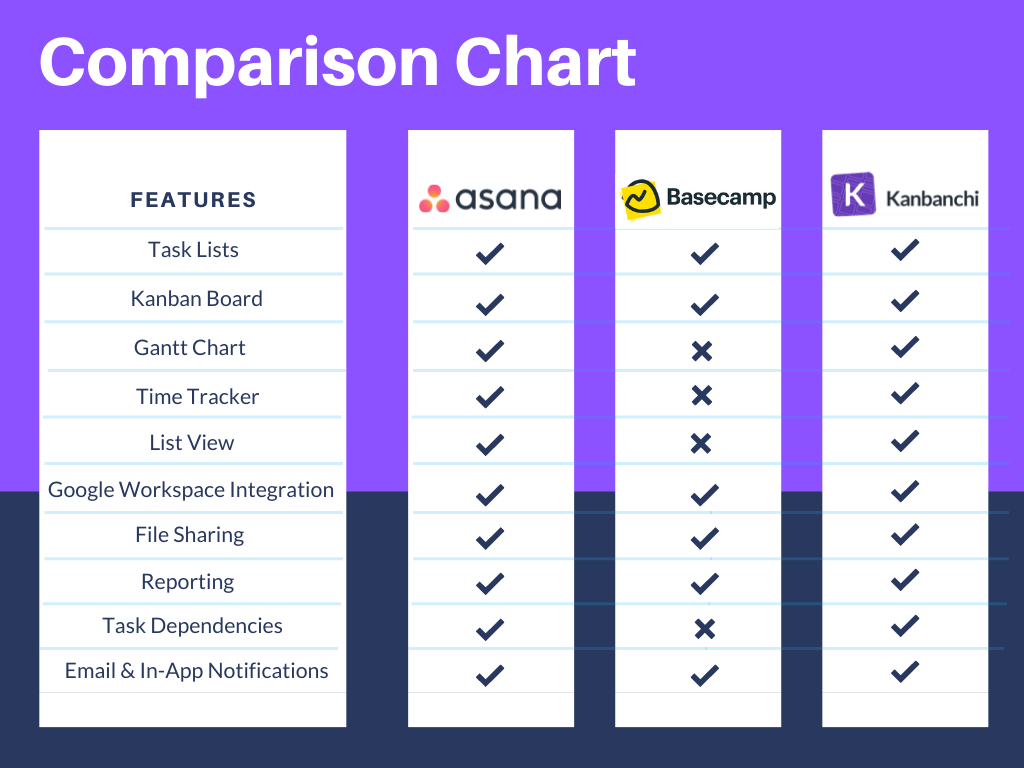
Basecamp vs. Asana vs. Kanbanchi (freelancer’s point of view)
No matter the size of the project, you need to keep your tasks on track. Even with plenty of planning, team members can lose sight of their responsibilities, deadlines, and progress. That’s where collaboration software comes into play, helping you organize projects and track their progress.
When it comes to managing tasks there are so many project management apps available for you to choose from. Basecamp, Kanbanchi, Asana, Trello, Wrike…the list goes on. Each tool has its own pros and cons and sometimes it’s difficult for organizations and freelancers to find the right fit for their needs. They need to consider all the functions and features that these collaboration tools offer, in order to determine which product best meets their team’s needs.
There are a few things that people expect when they look for collaboration or task management software. I am a freelance writer, and I’ve tried out Kanbanchi, Basecamp, and Asana apps myself. I work remotely and I was looking for the best app to manage all of my projects at once. For me, it was important to be able to track time and have a Gantt Chart view. So after using these apps for a while, I have my personal favorite. And in this article, I want to share with you some of the most significant differences between Basecamp, Asana, and Kanbanchi that you should know about before making a purchase.
Basecamp, Asana and Kanbanchi Comparison
We’ll begin by discussing a few similarities between Kanbanchi, Basecamp, and Asana. These tools are highly customizable, allowing for comprehensive project monitoring and management. This includes tools that help to manage tasks, assign team members, and keep all users informed about the overall progress of a project.
If you will take a look at this chart, you may see which features each software offers to its clients.

What do they look like and what do they do?
Kanbanchi
Kanbanchi was founded in 2014 by MagicWebSolutions. They have been developing software for startups for 20 years and Kanbanchi was their very first own product. Their main focus is the Google Workspace users niche. It is a collaboration app that gives you the visual tools to track, organize, and communicate shared projects. Kanban Board, Gantt Chart, and Time Tracker are three unique features that have made this application so successful. But it offers much more advanced tools for a very reasonable price.
If you’re using Kanbanchi, you can easily organize your workflow. Also, all the data is easily accessible for everyone. You can create and share an unlimited number of boards and cards, share them, attach files from Google Drive and Shared Drive, easily sort and filter cards and leave comments. Kanbanchai will make your team more efficient and productive with this collaborative and visual approach to work and project management.
Asana
Asana was founded in 2008 and launched in 2011 by Dustin Moskovitz which is a Facebook co-founder and Justin Rosenstein, he’s an ex-Google engineer. Asana is a team-based project collaboration and task management tool. It incorporates tools for project management, time tracking, agile software development and task management in one application. Its features include kanban boards for managing workflow, integrations with outside programs, and real-time performance feedback through progress bars when required tasks are not completed.
Basecamp
Basecamp, the project management tool created by the creators of 37signals. It was launched in 2004. Basecamp is a handy tool to help you connect with your team and streamline your project management. This tool offers group chats, messages, and document storage. It helps teams communicate quickly and effectively, even if they’re continents apart. It centralizes communication about projects, allowing everyone to work together on them from wherever they are. Basecamp lets you collaborate with teammates, post updates on projects, and keep schedules in order. Its features help you to manage and execute tasks for the project, including lists of tasks, document and file sharing, and discussion forums.
What’s the pricing?
Basecamp
Basecamp seems to be the most expensive one with a rate of $99 per month. But this monthly rate includes all the features that Basecamp can offer. So by paying $1,200 a year, you will get everything, and there’s no need to upgrade plans. Also if you add more people to the team, the less you have to pay per person. It may work for some teams, but if paying almost a hundred US dollars a month seems too pricey for you, let’s take a look at the other apps’ prices.
Asana
Asana offers a limited free version, which includes calendars, task lists, boards, and integrations. The premium plan starts from $9.99 per user per month it differs by adding advanced searches, custom field creation, timelines, and admin privileges. The business plan starts from $19.99 per user per month, it upgrades to having portfolios, automatic proofing, workload, and forms. The enterprise plan pricing is negotiated with the customer. It adds up data exporting, custom branding, provisioning, and priority support.
Kanbanchi
Kanbanchi offers a free version that includes all the advanced features of the app. The only limit is 10 cards per board. The Premium plan starts from $13.97 per user per month and includes unlimited projects and templates, dependent, related, and sub-cards, email, mobile & in-app notifications, export/import, and backups. The Professional plan starts from $33.97 per user per month, and it includes all the previous features and Gantt chart, time tracker, extensive reporting, and custom branding. And the Enterprise plan starts from $99.95 per user per month and includes all the previous features and designated account manager, onboarding assistance, online & onsite training, custom features, custom integrations with your existing software.
Here’s the best part – Kanbanchi offers a 50% discount to educational institutions and non-profits. It is great when SaaS cares about educators and non-profit workers. Also, there’s a special free domain-wide version for educators, and a lot of schools and universities are using Kanbanchi and are loving this great opportunity.
How easy or hard is it to use?
Asana
Asana has an intuitive user interface, but it seems to be hard to understand, as it provides lots of different options to choose from. It can be easy to get overwhelmed with all of the different features, even for people who have previous task management experience.
Basecamp
Basecamp makes keeping track of everything pretty easy, it is even more apparent with the ease of use of their software. While there are lots of different projects, there are also lots of different categories that they can be assigned to.
Kanbanchi
Out of all three apps, Kanbanchi is the easiest to understand. When I was reading reviews to each software, Kanbanchi’s reviews always included “ease-of-use” comments, and now I understand why. It’s very simple, not complicated at all software. Not only tech-savvy employees will be able to use it, but even junior-level staff will also understand it. It has an intuitive and user-friendly interface, so all team members should be able to pick up very quickly.
Takeaway
Based on my comparison, Kanbanchi is the winner. However, you should always take your specific needs into consideration. While Asana offers more features, Basecamp has faster support, Kanbanchi offers all of that together in one app. When it comes to ease of use, Kanbanchi is the best, no questions asked. The choice depends on what kind of collaborative tool you’re looking for. If you’re looking for advanced features and want to get more detailed with tracking your team workload with the best price, then Kanbanchi is the tool you’re looking for.
